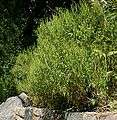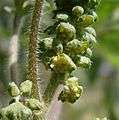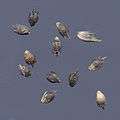Ambrosia artemisiifolia
| Ambrosia artemisiifolia | |
|---|---|
.jpg) | |
| Scientific classification | |
| Kingdom: | Plantae |
| (unranked): | Angiosperms |
| (unranked): | Eudicots |
| (unranked): | Asterids |
| Order: | Asterales |
| Family: | Asteraceae |
| Genus: | Ambrosia |
| Species: | A. artemisiifolia |
| Binomial name | |
| Ambrosia artemisiifolia L. | |
| Synonyms | |
| |
Ambrosia artemisiifolia, with the common names common ragweed, annual ragweed, and low ragweed, is a species of the genus Ambrosia native to regions of the Americas.[1][2]
Taxonomy
The species name, artemisiifolia, is given because the leaves were thought to bear a resemblance to the leaves of Artemisia, the true wormwoods.
It has also been called the common names: American wormwood, bitterweed, blackweed, carrot weed, hay fever weed, Roman wormwood, short ragweed, stammerwort, stickweed, tassel weed.[1][3]
Distribution
The plant is native to: North America across Canada, the eastern and central United States, the Great Plains, and in Alaska; the Caribbean on Cuba, Hispaniola, and Jamaica; and South America in the southern bioregion (Argentina, Chile, Paraguay, Uruguay), the western bioregion (Bolivia, Peru), and Brazil.[1][4][5][6] The distribution of common ragweed in Europe is expected to expand northwards in the future [7]
It is the most widespread species of the genus in North America, which most of the other species of Ambrosia are endemic to.
Description
Ambrosia artemisiifoliais an annual plant that emerges in late spring. It propagates mainly by rhizomes, but also by seed.[3]
It is much-branched, and grows up to 7 decimetres (2.3 ft) in height.[8] The pinnately divided soft and hairy leaves are 3–12 centimetres (1.2–4.7 in) long.[8]
Its bloom period is July to October in North America.[8] Its pollen is wind-dispersed, and can be a strong allergen to people with hay fever.[3][9]
It produces 2–4 mm obconic green to brown fruit.[8] It sets seed in later summer or autumn. Since the seeds persist into winter and are numerous and rich in oil, they are relished by songbirds and upland game birds.[3]
Invasive species
Common ragweed, Ambrosia artemisiifolia, is a widespread invasive species, and can become a noxious weed, that has naturalized in: Europe; temperate Asia and the Indian subcontinent; temperate northern and southern Africa and Macronesia; Oceania in Australia, New Zealand, and Hawaii; and Southwestern North America in California and the Southwestern United States.[1][8][10][11][12][13][14][15]
Common ragweed is a very competitive weed and can produce yield losses in soybeans as high as 30%. Control with night tillage reduces emergence by around 45%. Small grains in rotation will also suppress common ragweed if they are overseeded with clover. Otherwise, the ragweed will grow and mature and produce seeds in the small grain stubble.
Its wind-blown pollen is additionally highly allergenic.
Ragweed control
As of 2005 several herbicides were effective against common ragweed, although resistant populations were known to exist.[16] In 2007 several Ambrosia artemisiifolia populations were glyphosate resistant, exclusively in the USA.[17]
As of 2014 the ragweed leaf beetle, Ophraella communa, has been found south of the Alps in southern Switzerland and northern Italy. Many of the attacked plants were completely defoliated.[18] Zygogramma suturalis was introduced to Russia, and then China, for ragweed control, with very positive initial results.
SMARTER is a European interdisciplinary network of experts involved in the control of ragweed, health care professionals, aerobiologists, ecologists, economists, and atmospheric and agricultural modellers.[19]
Uses
Medicinal
Ambrosia artemisiifolia was a traditional medicinal plant for Native American tribes, including the Cherokee, Lakota, Iroquois, Dakota, and Delaware.[20]
Phytoremediation
Ambrosia artemisiifolia is used in phytoremediation projects remediating soil pollution, for removing heavy metals such as Lead from contaminated soil.[21]
Gallery
 Plant from distance
Plant from distance Close-up of leaf
Close-up of leaf Inflorescence (male capitules)
Inflorescence (male capitules) Close-up of male capitules
Close-up of male capitules Female flowers in leaf axil
Female flowers in leaf axil Achenes
Achenes Pollen core (scanning electron microscope)
Pollen core (scanning electron microscope)
| Wikimedia Commons has media related to Ambrosia artemisiifolia. |
References
- 1 2 3 4 GRIN—Germplasm Resources Information Network; Global Web v 1.9.7.1: report on Ambrosia artemisiifolia . accessed 26 August 2016.
- ↑ Calflora: Ambrosia artemisiifolia
- 1 2 3 4 NPIN−Lady Bird Johnson Wildflower Center Native Plant Information Network: Ambrosia artemisiifolia
- ↑ Bonap.net: Biota of North America Program county distribution map (2014)
- ↑ Hokche, O., P. E. Berry & O. Huber. (eds.) 2008. Nuevo Catálogo de la Flora Vascular de Venezuela 1–859. Fundación Instituto Botánico de Venezuela, Caracas.
- ↑ Jørgensen, P. M., M. H. Nee & S. G. Beck. (eds.) 2015 en adelante. Catalogo de las plantas vasculares de Bolivia (adiciones).
- ↑ Rasmussen, Karen; Thyrring, Jakob; Muscarella, Robert; Borchsenius, Finn (16 March 2017). "Climate-change-induced range shifts of three allergenic ragweeds ( L.) in Europe and their potential impact on human health". PeerJ. 5: e3104. doi:10.7717/peerj.3104.
- 1 2 3 4 5 Jepson eFlora (TJM2): Ambrosia artemisiifolia . accessed 26 August 2016.
- ↑ Newscientist.com: "North American ragweed to bring autumn allergy misery to Europe."
- ↑ Flora of North America Vol. 21 Page 15 Ambrosia artemisiifolia Linnaeus, Sp. Pl. 2: 988. 1753.
- ↑ Flora of China Vol. 20-21 Page 876, 877 豚草 tun cao Ambrosia artemisiifolia Linnaeus, Sp. Pl. 2: 988. 1753.
- ↑ Altervista.org: Flora Italiana − Ambrosia artemisiifolia L.
- ↑ Atlas of Living Australia: Ambrosia artemisiifolia (Annual Ragweed)
- ↑ INRA - The common ragweed
- ↑ Circabc.europa.eu; Final report: "EC Assessing and Controlling the spread and the effects of Common ragweed in Europe"
- ↑ A. Davis, K. Renner, C. Sprague, L. Dyer, D. Mutch (2005). Integrated Weed Management. MSU.
- ↑ Stephen B Powles (April 2008). "Evolved glyphosate-resistant weeds around the world: lessons to be learnt". Pest Management Science Pest Management Science. 64 (4): 360–365. doi:10.1002/ps.1525.
- ↑ Ophraella communa, the ragweed leaf beetle, has successfully landed in Europe: fortunate coincidence or threat? Weed Research, Volume 54, Issue 2, pages 109–119, April 2014, DOI: 10.1111/wre.12072
- ↑ Cf. www.ragweed.eu. The project runs from 2013 to 2017 in the frame of the EU programme COST. More than 120 participants from 33 countries are participating in 2013.
- ↑ BRIT.org: Native American Ethnobotany Database on Ambrosia artemisiifolia . accessed 26 August 2016.
- ↑ Pubs.acs.org: Phytoremediation + Ambrosia artemisiifolia
External links
- Essl, F., Biró, K., Brandes, D., Broennimann, O., Bullock, J.M., Chapman, D.S., Chauvel, B., Dullinger, S., Fumanal, B., Guisan, A. and Karrer, G., 2015. Biological flora of the British Isles: Ambrosia artemisiifolia. Journal of Ecology, 103(4), pp.1069-1098.
- USDA Plants Profile for Ambrosia artemisiifolia (annual ragweed)
- GRIN: Species profile of Ambrosia artemisiifolia
- Calflora Database: Ambrosia artemisiifolia (Annual ragweed, Common ragweed, Low ragweed) — non-native/naturalized species in California.
- Jepson Manual eFlora (TJM2) treatment of Ambrosia artemisiifolia — non-native/naturalized species in California.
- UC CalPhotos gallery: Ambrosia artemisiifolia